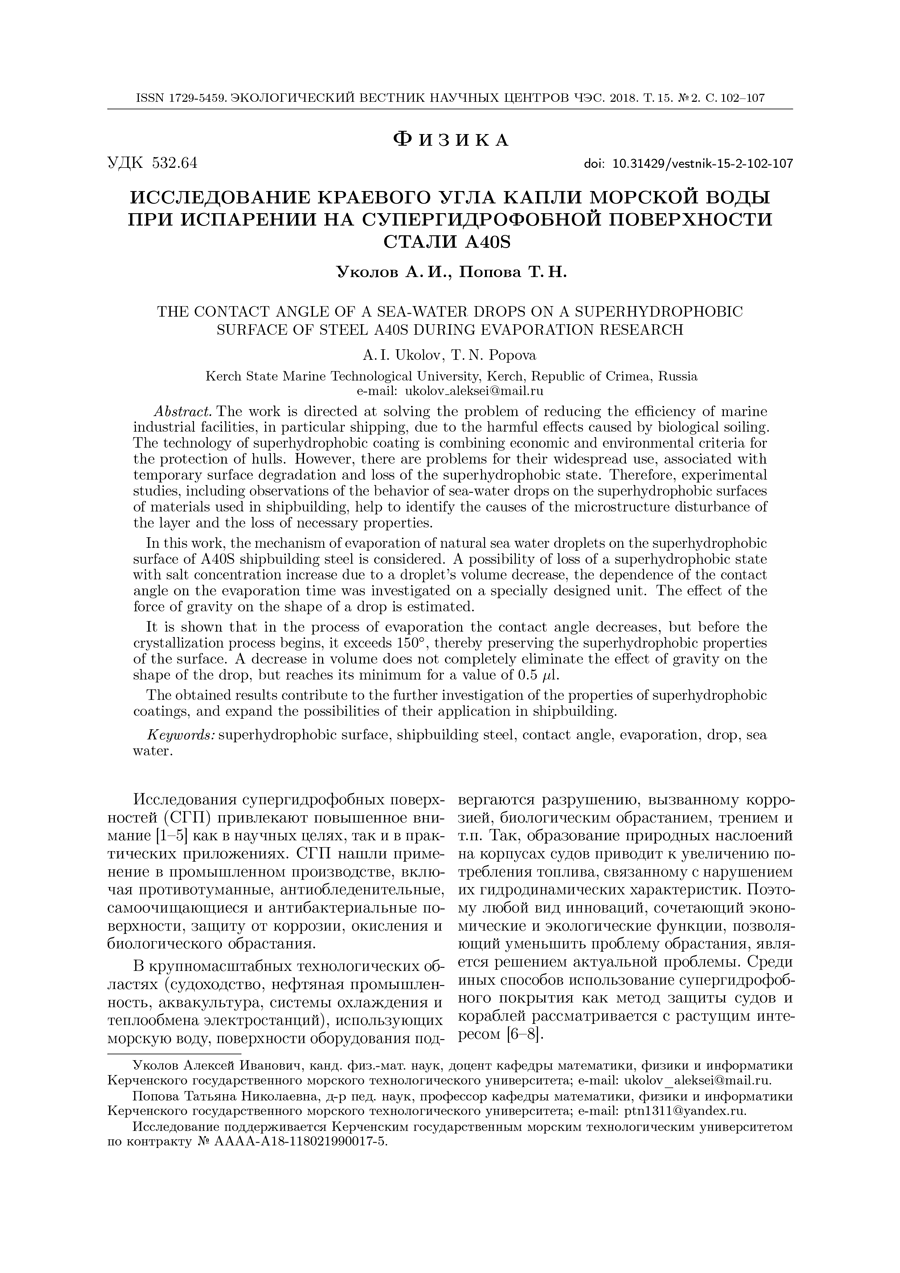The contact angle of a sea-water drops on a superhydrophobic surface of steel A40S during evaporation research
UDC
532.64DOI:
https://doi.org/10.31429/vestnik-15-2-102-107Abstract
The work is directed at solving the problem of reducing the efficiency of marine industrial facilities, in particular shipping, due to the harmful effects caused by biological soiling. The technology of superhydrophobic coating is combining economic and environmental criteria for the protection of hulls. However, there are problems for their widespread use, associated with temporary surface degradation and loss of the superhydrophobic state. Therefore, experimental studies, including observations of the behavior of sea-water drops on the superhydrophobic surfaces of materials used in shipbuilding, help to identify the causes of the microstructure disturbance of the layer and the loss of necessary properties.
In this work, the mechanism of evaporation of natural sea water droplets on the superhydrophobic surface of A40S shipbuilding steel is considered. A possibility of loss of a superhydrophobic state with salt concentration increase due to a droplet´s volume decrease, the dependence of the contact angle on the evaporation time was investigated on a specially designed unit. The effect of the force of gravity on the shape of a drop is estimated.
It is shown that in the process of evaporation the contact angle decreases, but before the crystallization process begins, it exceeds 150º, thereby preserving the superhydrophobic properties of the surface. A decrease in volume does not completely eliminate the effect of gravity on the shape of the drop, but reaches its minimum for a value of 0.5 μl.
The obtained results contribute to the further investigation of the properties of superhydrophobic coatings, and expand the possibilities of their application in shipbuilding.
Keywords:
superhydrophobic surface, shipbuilding steel, contact angle, evaporation, drop, sea waterAcknowledgement
References
- Chu, Z., Seeger, S. Superamphiphobic surfaces. Chemical Society Reviews, 2014, vol. 43, pp. 2784-2798.
- Ragesh, P. at al. A review on self-cleaning and multifunctional materials. J. of Materials Chemistry A, 2014, vol. 2, pp. 14773-14797.
- Tam, J., Palumbo, G., Erb, U. Recent Advances in Superhydrophobic Electrodeposits. Materials, 2016, vol. 9, no. 3, pp. 151-178.
- Pridvorov, B. N., Popova, T.N., Ukolov, A.I. Superhydrophobic surfaces. Review. Obrazovanie, nauka i molodezh' - 2017 [Education, Science and Youth - 2017], 2017, vol. 2, pp. 107-120. (In Russian)
- Zhang, P., Lv, F.Y. A review of the recent advances in superhydrophobic surfaces and the emerging energy-related applications. Energy, 2015, vol. 82, pp. 1068-1087.
- Ferrari, M., Benedetti, A. Superhydrophobic surfaces for applications in seawater. Advances in Colloid and Interface Science, 2015, vol. 222, pp. 291-304.
- Samaha, M.A., Tafreshi, H.V., Gad-el-Hak, M. Superhydrophobic surfaces: From the lotus leaf to the submarine. Comptes Rendus Mecanique, 2012, vol. 340, pp. 18-34.
- Genzer, J., Efimenko, K. Recent developments in superhydrophobic surfaces and their relevance to marine fouling: a review. Biofouling, 2006, vol. 22, no. 5, pp. 339-360.
- Gupta, R., Vaikuntanathan, V., Sivakumar, D. Superhydrophobic qualities of an aluminum surface coated with hydrophobic solution NeverWet. Colloids and Surfaces A: Physicochemical and Engineering Aspects, 2016, vol. 500, pp. 45-53.
- Kikoin, A.K., Kikoin, I.K. General course of physics. Molecular physics. Nauka, Moscow, 1976. (In Russian)
- Zhao, T., Jiang, L. Contact angle measurement of natural materials. Colloids and Surfaces B: Biointerfaces, 2018, vol. 161, pp. 324-330.
- Zhang, X., at al. Polyelectrolytemultilayer as matrix for electrochemical deposition of gold clusters: towardsuper-hydrophobic surface. J. Am. Chem. Soc., 2004, vol. 126, pp. 3064-3065.
Downloads
Submitted
Published
How to Cite
Copyright (c) 2018 Ukolov A.I., Popova T.N.

This work is licensed under a Creative Commons Attribution 4.0 International License.




